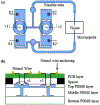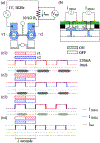A microfluidic system integrated with shape memory alloy valves for a safe direct current delivery system
- PMID: 33018768
- PMCID: PMC12302988
- DOI: 10.1109/EMBC44109.2020.9176474
A microfluidic system integrated with shape memory alloy valves for a safe direct current delivery system
Abstract
Direct current (DC) has potential as a clinical and scientific tool to accelerate wound healing, increase the permeability of the skin to drug treatment and modulate neural activity. But long duration delivery of DC unavoidably causes hazardous electrolysis at the tissue-electrode interface. To be able to deliver long duration DC, we previously proposed a design for a safe direct current stimulator (SDCS). This device uses alternating current that does not cause chemical reactions at the metal electrodes within the device, but delivers ionic direct current output to the tissue via microfluidic valves. We previously developed and published designs of multiple SDCS components including microfluidic, electronic, data processing, and energy systems. In this paper we focus on the development of the integrated microfluidics needed by the SDCS system. We developed a fabrication method and characterized valve performance within the multi-valve microfluidic system. We used poly-dimethylsiloxane (PDMS) to fabricate three microfluidic chips that integrated valves actuated by 50-µm Nitinol (NiTi) shape memory alloy (SMA) wire. We tested system operation by driving SMA valves with a current pulse and recording the valve response with an electrical assay. The valve operation complied with the SDCS system requirements. The time for valves to open was rapid at 0.177 ± 0.04 seconds, and the time for the valves to close was 0.265 ± 0.05 seconds. Open microfluidic channel impedance for unrestricted ionic current flow was 15.90 ± 8.28 kΩ and it increased by a factor of 40 to restrict ionic current flow at 678 ± 102 kΩ for the closed valves.
Figures





Similar articles
-
A Novel Design of a Portable Birdcage via Meander Line Antenna (MLA) to Lower Beta Amyloid (Aβ) in Alzheimer's Disease.IEEE J Transl Eng Health Med. 2025 Apr 10;13:158-173. doi: 10.1109/JTEHM.2025.3559693. eCollection 2025. IEEE J Transl Eng Health Med. 2025. PMID: 40657533 Free PMC article.
-
Short-Term Memory Impairment.2024 Jun 8. In: StatPearls [Internet]. Treasure Island (FL): StatPearls Publishing; 2025 Jan–. 2024 Jun 8. In: StatPearls [Internet]. Treasure Island (FL): StatPearls Publishing; 2025 Jan–. PMID: 31424720 Free Books & Documents.
-
Initial arch wires used in orthodontic treatment with fixed appliances.Cochrane Database Syst Rev. 2018 Jul 31;7(7):CD007859. doi: 10.1002/14651858.CD007859.pub4. Cochrane Database Syst Rev. 2018. Update in: Cochrane Database Syst Rev. 2024 Feb 06;2:CD007859. doi: 10.1002/14651858.CD007859.pub5. PMID: 30064155 Free PMC article. Updated.
-
Clinical symptoms, signs and tests for identification of impending and current water-loss dehydration in older people.Cochrane Database Syst Rev. 2015 Apr 30;2015(4):CD009647. doi: 10.1002/14651858.CD009647.pub2. Cochrane Database Syst Rev. 2015. PMID: 25924806 Free PMC article.
-
Automated devices for identifying peripheral arterial disease in people with leg ulceration: an evidence synthesis and cost-effectiveness analysis.Health Technol Assess. 2024 Aug;28(37):1-158. doi: 10.3310/TWCG3912. Health Technol Assess. 2024. PMID: 39186036 Free PMC article.
References
-
- Kloth LC and Feedar JA, “Acceleration of wound healing with high voltage, monophasic, pulsed current,” Phys. Ther, 1988. - PubMed
-
- Banga AK, Donnelly R, and Stinchcomb AL, “Transdermal drug delivery,” Therapeutic Delivery. 2013.
-
- Prausnitz MR, “The effects of electric current applied to skin: A review for transdermal drug delivery,” Advanced Drug Delivery Reviews. 1996.
MeSH terms
Substances
Grants and funding
LinkOut - more resources
Full Text Sources
